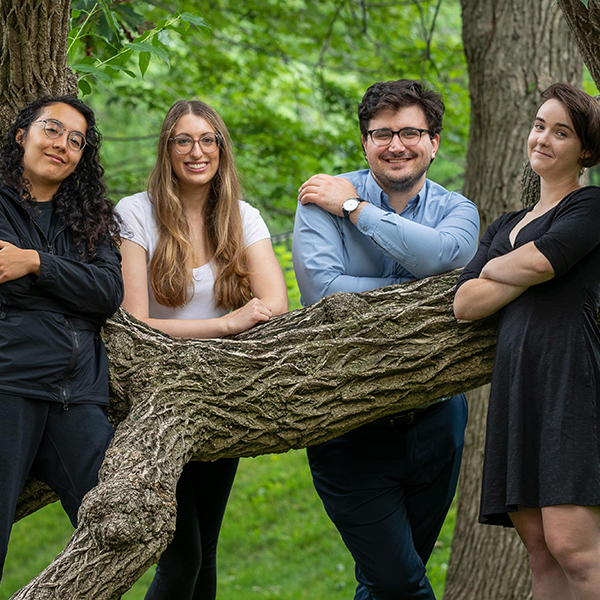Three male patients who had been partially or completely paralyzed from the waist down for years are able to walk again, thanks to a novel combination of precise electrical stimulation of their spinal cords and intensive, robot-assisted overground body weight support training.
A team of Swiss scientists, led by neuroscientist Gregoire Courtine from the Ecole Polytechnique Fédérale de Lausanne and neurosurgeon Jocelyn Bloch of the Lausanne University Hospital, earned international attention last month when they reported the breakthrough results from the STIMO (STimulation Movement Overground) study in the journal Nature.
McGill nursing graduate Molywan Vat, BSc’10, MSc’13, was hired by Bloch as clinical trial coordinator in 2016 and has played a pivotal role in helping steer the team toward a successful outcome.
“I work with the engineering team who develop our technology devices, the clinicians and the physical therapists. I’m the eye of the clinical PI, Dr. Bloch, and assist her in the operating room implanting the electrodes and neurostimulator. I’m also the hotline for patients on their health and medical issues,” says Vat, who took elective neuroscience courses at McGill and worked as a clinical trial coordinator at the Institut de Cardiologie de Montréal after graduating.
Each patient had an array of 16 electrodes surgically implanted in the epidural space of the spinal cord and a wireless pulse stimulator implanted under the skin, which transmits the electrical pulses to the spinal cord. The electrodes target nerve connections to specific muscle groups in the legs and are configured to activate specific regions of the spinal cord, reproducing the signals that the brain would deliver when we walk.
The precise timing and location of the electrical stimulation – like a Swiss watch – is crucial to patients initiating and controlling their muscle movements. “This method allows us to target motor neurons needed for movement in gait patterns in a natural way. For each patient, the stimulation parameters are specifically tailored and optimized to maximize their capacity to walk,” explains Vat.
The patients had to learn how to coordinate their intention to walk with the targeted stimulation. But within a week of starting treatment, they progressed from stepping on a treadmill to supported walking on the ground. After months of training, the patients were able to walk hands-free for more than a kilometre on a treadmill using stimulation, without showing signs of muscle fatigue or a deterioration in stepping quality.
Eventually, they could move their leg muscles even when the electrical stimulation was turned off. This suggests nerve connections between the brain, spinal cord and muscles were regenerated and remapped during treatment.
Keeping the patients healthy, motivated and able to successfully complete intense neurorehabilitation training four times a week for five months was a challenge that required a range of nursing skills.
“In the master’s nursing program, I learned about holistic care and understanding the patient’s perspective. You need to be a psychologist and it was important for these patients to gain confidence and hope to get the maximum benefit from the training. The Dutch patient, for example, was feeling isolated because he was living far from home. When he was lonely, I suggested social activities he would enjoy.”
Vat coached and encouraged team members to communicate effectively with patients. “When I joined the project, the engineers didn’t have experience working with patients – they’d done studies with rats. I taught them how to behave and be professional with patients,” he says.
Preventing injuries was another challenge. “Due to their spinal cord injuries, patients are at risk of bone fracture, ankle sprain, scoliosis, falls and muscle inflammation during the training phase. We were able to optimize rehabilitation to minimize injury risk. Physical therapists were supervising each training session and I was there to get the necessary medical follow-up for adverse events,” explains Vat.
McGill physical therapy graduate Valentin Radevich, BSC’16, MSc’17, who did a master’s neurology rehabilitation internship at Lausanne University Hospital, joined the STIMO team last August to work with patients in the training sessions. “The engineers have come up with new techniques for rehabilitation, which can be customized for each patient’s walking pattern, so their walking becomes more natural and fluid. It’s exciting to be part of a breakthrough that’s changing their lives,” says Radevich.
As trial coordinator and nurse, Vat has helped to ensure the patients’ perspectives and interests remain central and that this advanced research has immediate practical benefits for them. “In the nursing program, we learned the patient is equal to the clinician. Patients always come with new knowledge, and patients and clinicians can learn from each other,” he says.
For example, a Swiss patient in the study, who’s an engineer, had designed and built a three-wheeled lying down bike for paraplegics. The researchers learned from him and adapted his bike, so he can cycle better by using electrical stimulation. They also designed tools –a tablet and voice-activated watch — that allow patients to turn the electrodes on or off. “This gives them the autonomy to train at home on their own,” says Vat.
In the future, the STIMO team plans to test a next-generation version of the treatment very early after injury, when the neuromuscular system has undergone less atrophy and the potential for recovery is higher. “We’ll try implanting the electrodes a month after injury and train patients at the bedside in hospital. Our goal is to make the treatment widely accessible and improve each spinal cord patient’s quality of life as much as possible,” says Vat.


